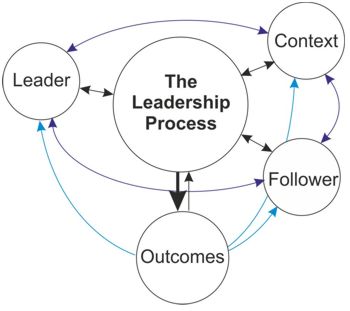What is the Leadership Process Model?
The Leadership Process Model was developed by Randall B. Dunham and Jon Pierce, and was published in their 1989 book "Managing." You can see our interpretation of the model in figure 1, below. (It has been redrawn this for clarity.)
Figure 1 – The Leadership Process

The model shows the relationship between four key factors that contribute to leadership success or failure. These are:
- The Leader: This is the person who takes charge, and directs the group's performance.
- Followers: These are the people who follow the leader's directions on tasks and projects.
- The Context: This is the situation in which the work is performed. For instance, it may be a regular workday, an emergency project, or a challenging, long-term assignment. Context can also cover the physical environment, resources available, and events in the wider organization.
- Outcomes: These are the results of the process. Outcomes could be reaching a particular goal, developing a high-quality product, or resolving a customer service issue. They can also include things like improved trust and respect between the leader and followers, or higher team morale.
Key Points
The Leadership Process Model highlights the dynamic and long-term nature of leadership. It shows how your actions and behaviors influence your people, just as their actions and behaviors influence you.
As well as having an awareness of the model, you can also apply lessons from it by doing the following:
- Providing regular feedback.
- Being aware of actions and reactions.
- Leading honestly and ethically.
- Leading with the right style.
- Assigning tasks consciously and intelligently.
- Focusing on relationship development.
“The challenge of leadership is to be strong, but not rude; be kind, but not weak; be bold, but not bully; be thoughtful, but not lazy; be humble, but not timid; be proud, but not arrogant; have humor, but without folly.” - Jim Rohn
"If your actions inspire others to dream more, learn more, do more and become more, you are a leader." - John Quincy Adam
No comments:
Post a Comment